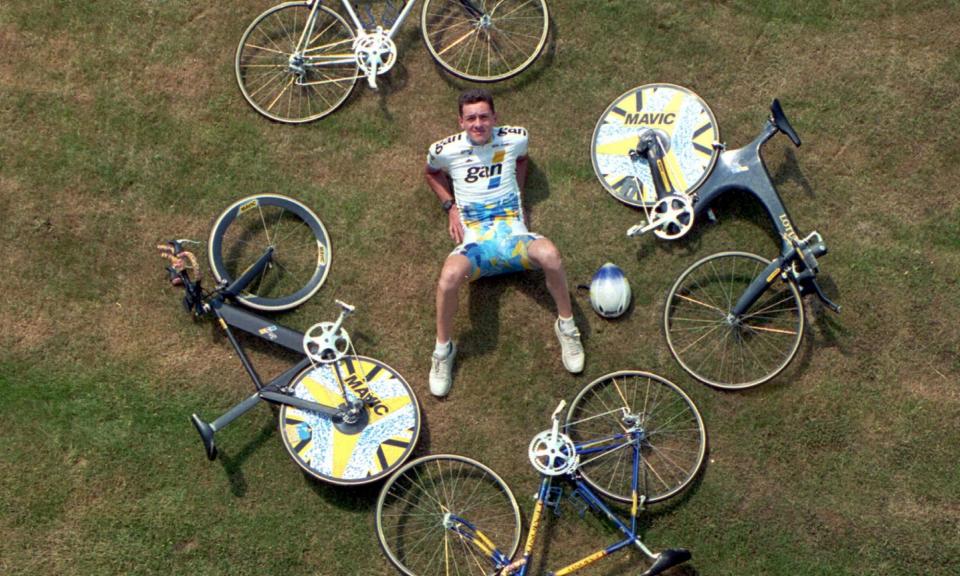How Chris Boardman changed the game for the Tour de France in 1994

This time 30 years ago Chris Boardman was a very nervous young man, the biggest moment in his sporting life only a few days away. The prologue time trial of the 1994 Tour de France in Lille on 2 July was looming; Boardman had been fast-tracked unexpectedly into the race by his French team having made a meteoric start to his professional racing career. He was already an Olympic champion, in the pursuit in Barcelona in 1992, and had taken the Hour record the previous year, but this was on a very different scale in its implications for him – “a gamechanging moment for me personally”, he recalls, and there would be ramifications for his sport that are still seen today.
Boardman is now the chair of Sport England, and the government’s active travel commissioner; he was appointed a CBE in the king’s birthday honours, but he recalls that in 1994 he was “a kid, horribly arrogant, scared and self-obsessed”. The nerves made him play down his chances of success when I met him a few days before the race. Boardman claimed he was “not 100%”, his form “had fallen off a bit” and he was worried about his health; it was nonsense, of course, as he realised once he set off down the start ramp outside Lille’s brand new Eurostar station in the gathering dusk.
Related: Arise, Sir Cav: Mark Cavendish awarded knighthood in king’s birthday honours
The Guardian had closely traced his progress that season, from a scared new professional who couldn’t believe the bike-handling ability of the seasoned racers around him – “I hated it, I didn’t have the skills” – to a rider who would win three stages in the Tour’s key warm-up race, the Critérium du Dauphiné. A week before the Tour, he broke the British 10‑mile record on a local course in north Wales; on the evening of 2 July, he became only the second British cyclist to wear the coveted yellow jersey, 32 years after Tom Simpson’s single day in the maillot jaune.
The evening was summed up in a single image: the French rider Luc Leblanc, who had started a minute earlier, looking sideways in disbelief as Boardman streaked past him close to the finish, “with the power and majesty of one of the high speed trains that will flit in and out of the new TGV station”, the report says. Boardman’s victory margin over seven kilometres was astonishing: 15sec on Miguel Induráin, heading for his fourth successive Tour win, 19 on the triple Tour of Spain winner Tony Rominger. So, too, was his use of the radical Lotus carbon fibre bike, with its sleek filled-in carbon-fibre frame.
Boardman’s sympathy for Leblanc is limited: “Everyone had been caught with their pants down … because they’d been a bit lazy, then someone comes along who’d really thought about this bit of the event, who’d improved as much as they possibly could, and put it together on the day. It was just that no one had thought about it. Luc Leblanc had turned up on a bike you could get in Decathlon and had adjusted it on the morning of the race. I’d done dress rehearsals so many times, that prologue was just the application of it. I rode the course beforehand behind a car, which would pull out before each corner so that I could go through them at race speed. I must have known where every drain cover was. Everyone was there for a three-week race, I went for seven minutes.”
Nowadays, most cyclists at all levels pay attention to things aerodynamic, which is the main reason that race speeds at professional level are now stratospheric, while amateur races are faster than pro races a few years ago; in 1994, when Boardman came along, this was a novelty. “This was when a cottage industry realised the impact of technology, the moment when the Tour went ‘shit, this stuff is important’. No one had looked in from outside to see what could be done to change it.”
The dream scenario would have been for Boardman to wear yellow when the Tour spent two days meandering between Dover, Brighton and Portsmouth – unlike Simpson, he wore it for more than one day – but that hope was dashed when GAN flopped in the team time trial that took the race to the portal of the Channel tunnel, which had yet to open and which would transport the race to the UK, with horrendous delays and stress along the way.
Le Tour en Angleterre was an unexpected triumph, with millions lining the roadsides, a shock to seasoned French observers who recalled the low-key visit to Plymouth in 1974. It shocked Boardman too: “The scale of it was sensational, it was an ego trip for me, but there were 3.5 million people on the road and they didn’t know how to deal with it. We didn’t leverage the support for the race; people were bemused because once the race had gone there was nothing.”
The lessons were learned for the Tour’s hugely successful future visits in 2007 and 2014, but more broadly the two-day visit now looks like the moment when the race organisers woke up to the fact that its popularity extends way outside the traditional heartlands. A Grand Départ in Dublin followed four years later; London, Yorkshire, Düsseldorf and Copenhagen have staged Tour starts since then; the race is now a global brand, and that brief spell in 1994 seems like where it all began. A true turning point, and not just for Chris Boardman.

 Yahoo Sport
Yahoo Sport 






































